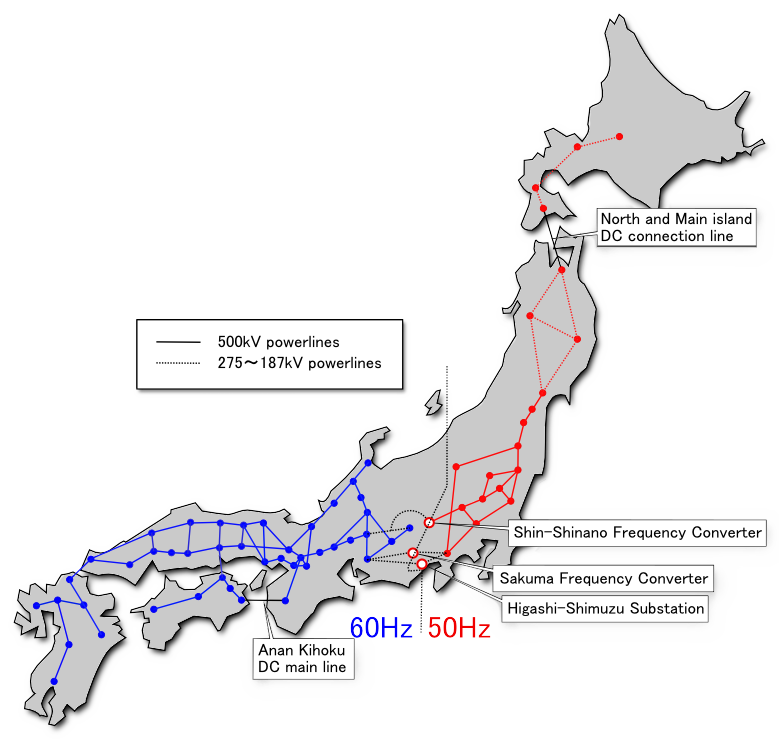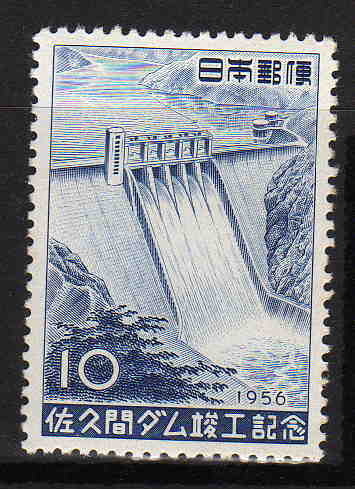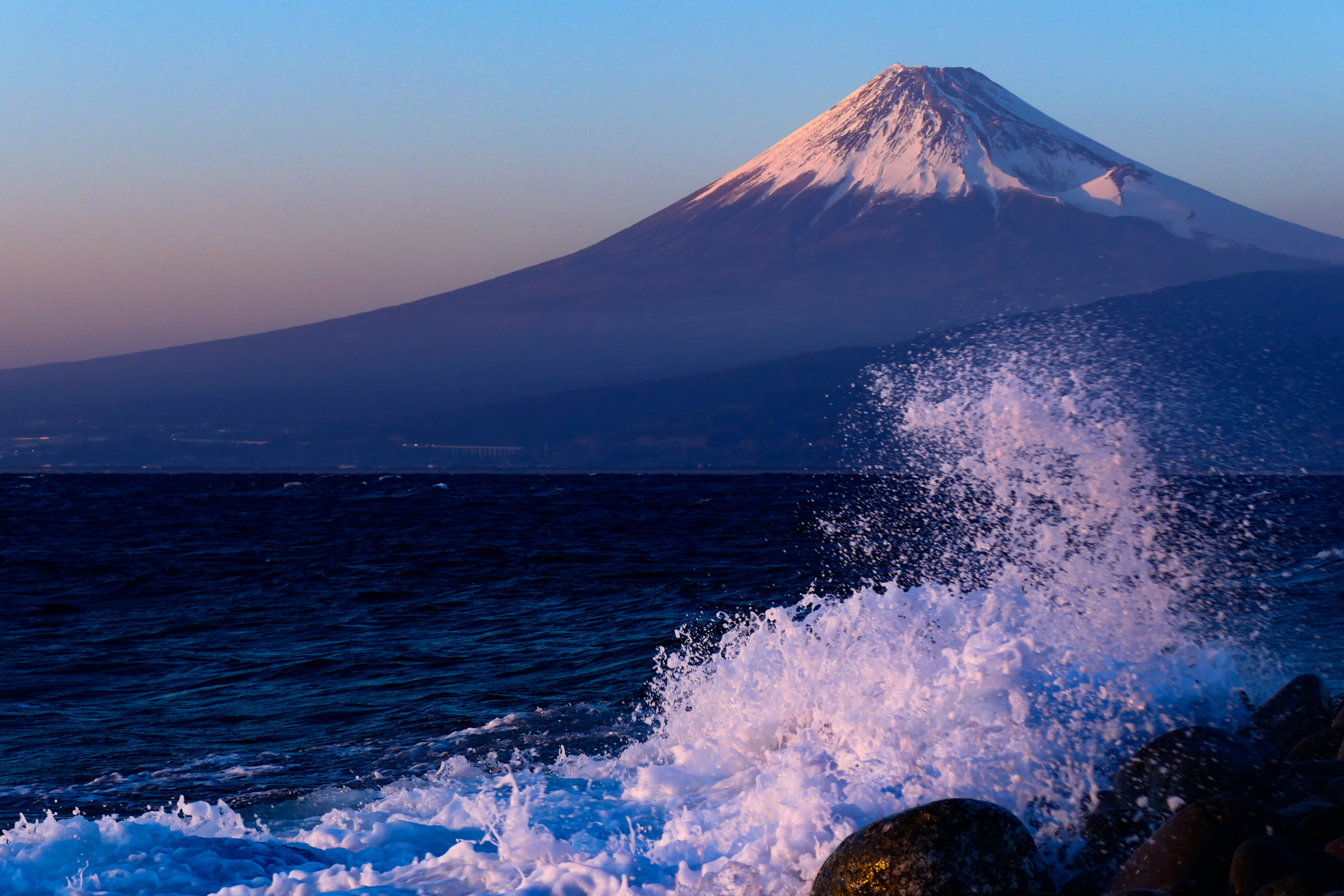|
Higashi-Shimizu Frequency Converter
is the third facility in Japan for interconnecting the power grid of eastern Japan, which operates at 50 hertz, and that of western Japan, which operates at 60 hertz. The Higashi-Shimizu Frequency Converter Station is operated by Chubu Electric Power Co. and is located at 677-3 Tanakake, Hirose-aza, Shimizu-ku, Shizuoka. It is fed via a 275 kV power line and a 154 kV power line. Its inverters operate at 125 kVDC and have a maximum transmission rate of 300 MW. Japan's other converter stations are at Shin-Shinano in Nagano Prefecture, Sakuma Dam in Shizuoka Prefecture, and Minami-Fukumitsu in Toyama Prefecture is a prefecture of Japan located in the Chūbu region of Honshu. Toyama Prefecture has a population of 993,848 (1 January 2025) and has a geographic area of 4,247.61 km2 (1,640.01 sq mi). Toyama Prefecture borders Ishikawa Prefecture to the .... See also * Electricity sector in Japan#Transmission * Energy in Japan External links * http://www.chuden.co ... [...More Info...] [...Related Items...] OR: [Wikipedia] [Google] [Baidu] |
Japan
Japan is an island country in East Asia. Located in the Pacific Ocean off the northeast coast of the Asia, Asian mainland, it is bordered on the west by the Sea of Japan and extends from the Sea of Okhotsk in the north to the East China Sea in the south. The Japanese archipelago consists of four major islands—Hokkaido, Honshu, Shikoku, and Kyushu—and List of islands of Japan, thousands of smaller islands, covering . Japan has a population of over 123 million as of 2025, making it the List of countries and dependencies by population, eleventh-most populous country. The capital of Japan and List of cities in Japan, its largest city is Tokyo; the Greater Tokyo Area is the List of largest cities, largest metropolitan area in the world, with more than 37 million inhabitants as of 2024. Japan is divided into 47 Prefectures of Japan, administrative prefectures and List of regions of Japan, eight traditional regions. About three-quarters of Geography of Japan, the countr ... [...More Info...] [...Related Items...] OR: [Wikipedia] [Google] [Baidu] |
Shin-Shinano Frequency Converter
is the designation of a back-to-back high-voltage direct current (HVDC) facility in Japan which forms one of four frequency converter stations that link Japan's western and eastern power grids. The other three stations are at Higashi-Shimizu, Minami-Fukumitsu, and Sakuma Dam. Converter equipment The HVDC back-to-back facility Shin Shinano uses line-commutated thyristor converters. The station houses two converters, one of which opened in December 1977,Compendium of HVDC schemes, CIGRÉ Technical Brochure No. 003, 1987, pp100–103. the other in 1992. The original 1977 converter was one of the first thyristor-based HVDC schemes to be put into operation in the world and used oil-insulated, oil-cooled outdoor thyristor valves supplied by Hitachi (60 Hz end) and Toshiba (50 Hz end). A special workshop was provided on the site, in which valve maintenance (for example replacing failed thyristors) could be carried out under clean conditions in order to avoid contami ... [...More Info...] [...Related Items...] OR: [Wikipedia] [Google] [Baidu] |
Electric Power Infrastructure In Japan
Electricity is the set of physical phenomena associated with the presence and motion of matter possessing an electric charge. Electricity is related to magnetism, both being part of the phenomenon of electromagnetism, as described by Maxwell's equations. Common phenomena are related to electricity, including lightning, static electricity, electric heating, electric discharges and many others. The presence of either a positive or negative electric charge produces an electric field. The motion of electric charges is an electric current and produces a magnetic field. In most applications, Coulomb's law determines the force acting on an electric charge. Electric potential is the work done to move an electric charge from one point to another within an electric field, typically measured in volts. Electricity plays a central role in many modern technologies, serving in electric power where electric current is used to energise equipment, and in electronics dealing with electrical c ... [...More Info...] [...Related Items...] OR: [Wikipedia] [Google] [Baidu] |
Converter Stations
Converter may refer to: Electromagnetics *Frequency converter *Voltage converter, another name for **Electromagnetic transformer **Switched-mode power supply **DC-to-DC converter **Power inverter (DC to AC) ***Solar inverter Electronics *Digital-to-analog converter *Analog-to-digital converter * "Frequency-to-Voltage converter" (F-V converter), a frequency detector for voltage-controlled guitar synthesizer * A combination local oscillator and mixer stage in a superheterodyne receiver *"Converter", an alternate name for a remote control In television *Cable converter box, an electronic device use in cable television systems *Digital television adapter, sometimes known as a "converter box" Information technology *Low-noise converter, in communications *Scan conversion between video formats *File format converter, for converting between various file formats *Currency converter, a piece of software for converting one currency into another Metallurgy *Converter (metallurgy), a devi ... [...More Info...] [...Related Items...] OR: [Wikipedia] [Google] [Baidu] |
Energy In Japan
Japan is a major consumer of energy, ranking fifth in the world by primary energy use. Fossil fuels accounted for 88% of Japan's primary energy in 2019. Japan imports most of its energy due to scarce domestic resources. As of 2022, the country imports 97% of its oil and is the largest liquefied natural gas (LNG) importer globally. Japan is increasing its reliance on renewable energy to replace imported fossil fuels, and in 2019 renewable energy accounted for 7.8% of primary energy supply. Japan has committed to reaching net zero emissions by 2050, setting a target to reduce GHG emissions by 46% from 2013 levels by 2030. Japan initiated its first commercial nuclear power reactor in 1966, establishing nuclear energy as a strategic national priority from 1973 onwards. Following the Fukushima nuclear accident in 2011, this strategy underwent re-evaluation but was ultimately upheld. Prior to the accident, nuclear reactors contributed about 30% of Japan's electricity, with t ... [...More Info...] [...Related Items...] OR: [Wikipedia] [Google] [Baidu] |
Electricity Sector In Japan
The electric power industry in Japan covers the generation, transmission, distribution, and sale of electric energy in Japan. Japan consumed approximately 918 terawatt-hours (TWh) of electricity in 2014. Before the 2011 Fukushima Daiichi nuclear disaster, about a quarter of electricity in the country was generated by nuclear power. In the following years, most nuclear power plants have been on hold, being replaced mostly by coal and natural gas. Solar power is a growing source of electricity, and Japan has the third largest solar installed capacity with about 50 GW as of 2017. Japan's electricity production is characterized by a diverse energy mix, including nuclear, fossil fuels, renewable energy, and hydroelectric power. Japan has the second largest pumped-hydro storage installed capacity in the world after China. The electrical grid in Japan is isolated, with no international connections, and consists of four wide area synchronous grids. Unusually, the Eastern and Western gr ... [...More Info...] [...Related Items...] OR: [Wikipedia] [Google] [Baidu] |
Toyama Prefecture
is a prefecture of Japan located in the Chūbu region of Honshu. Toyama Prefecture has a population of 993,848 (1 January 2025) and has a geographic area of 4,247.61 km2 (1,640.01 sq mi). Toyama Prefecture borders Ishikawa Prefecture to the west, Gifu Prefecture to the south, Nagano Prefecture to the east, and Niigata Prefecture to the northeast. Toyama is the capital and largest city of Toyama Prefecture, with other major cities including Takaoka, Imizu, and Nanto. Toyama Prefecture is part of the historic Hokuriku region, and the majority of the prefecture's population lives on Toyama Bay, one of the largest bays in Japan. Toyama Prefecture is the leading industrial prefecture on the Japan Sea coast and has the advantage of cheap electricity from abundant hydroelectric resources. Toyama Prefecture contains the only known glaciers in East Asia outside of Russia, first recognized in 2012, and 30% of the prefecture's area is designated as national parks. History ... [...More Info...] [...Related Items...] OR: [Wikipedia] [Google] [Baidu] |
Minami-Fukumitsu Frequency Converter
is the name given to an HVDC back-to-back station for the interconnection of the power grids of western and eastern Japan. This facility went in service in March 1999. It operates with a voltage of 125 kV and can transfer a power up to 300 megawatts. The station is located in Nanto, Toyama Prefecture is a prefecture of Japan located in the Chūbu region of Honshu. Toyama Prefecture has a population of 993,848 (1 January 2025) and has a geographic area of 4,247.61 km2 (1,640.01 sq mi). Toyama Prefecture borders Ishikawa Prefecture to the .... External links http://www.meppi.com/mepssd/NPDF3/BTB_MinamiFukumitsu.pdf Converter stations Electric power infrastructure in Japan Energy infrastructure completed in 1999 Nanto, Toyama 1999 establishments in Japan {{Toyama-geo-stub ... [...More Info...] [...Related Items...] OR: [Wikipedia] [Google] [Baidu] |
Sakuma Dam
The is a dam on the Tenryū River, located on the border of Toyone, Kitashitara District, Aichi Prefecture on the island of Honshū, Japan. It is one of the tallest dams in Japan and supports a 350 MW hydroelectric power station. Nearby a frequency converter station is installed, allowing interchange of power between Japan's 50 Hz and 60 Hz AC networks. History The potential of the Tenryū River valley for hydroelectric power development was realized by the Meiji government at the start of the 20th century. The Tenryū River was characterized by a high volume of flow and a fast current. Its mountainous upper reaches and tributaries were areas of steep valleys and abundant rainfall, and were sparsely populated. However, the bulk of investment in hydroelectric power generation in the region was centered on the Ōi River, and it was not until the Taishō period that development began on the Tenryū River. Private entrepreneur Fukuzawa Momosuke founded the , which la ... [...More Info...] [...Related Items...] OR: [Wikipedia] [Google] [Baidu] |
Nagano Prefecture
is a Landlocked country, landlocked Prefectures of Japan, prefecture of Japan located in the Chūbu region of Honshu. Nagano Prefecture has a population of 2,007,682 () and has a geographic area of . Nagano Prefecture borders Niigata Prefecture to the north, Gunma Prefecture to the northeast, Saitama Prefecture to the east, Yamanashi Prefecture to the southeast, Shizuoka Prefecture and Aichi Prefecture to the south, and Gifu Prefecture and Toyama Prefecture to the west. Nagano (city), Nagano is the capital and largest city of Nagano Prefecture, with other major cities including Matsumoto, Nagano, Matsumoto, Ueda, Nagano, Ueda, and Iida, Nagano, Iida. Nagano Prefecture has impressive highland areas of the Japanese Alps, including most of the Hida Mountains, Kiso Mountains, and Akaishi Mountains which extend into the neighbouring prefectures. The area's mountain ranges, natural scenery, and history has gained Nagano Prefecture international recognition as a winter sports tourist de ... [...More Info...] [...Related Items...] OR: [Wikipedia] [Google] [Baidu] |
Voltage
Voltage, also known as (electrical) potential difference, electric pressure, or electric tension, is the difference in electric potential between two points. In a Electrostatics, static electric field, it corresponds to the Work (electrical), work needed per unit of Electric charge, charge to move a positive Test particle#Electrostatics, test charge from the first point to the second point. In the SI unit, International System of Units (SI), the SI derived unit, derived unit for voltage is the ''volt'' (''V''). The voltage between points can be caused by the build-up of electric charge (e.g., a capacitor), and from an electromotive force (e.g., electromagnetic induction in a Electric generator, generator). On a macroscopic scale, a potential difference can be caused by electrochemical processes (e.g., cells and batteries), the pressure-induced piezoelectric effect, and the thermoelectric effect. Since it is the difference in electric potential, it is a physical Scalar (physics ... [...More Info...] [...Related Items...] OR: [Wikipedia] [Google] [Baidu] |
Shizuoka Prefecture
is a Prefectures of Japan, prefecture of Japan located in the Chūbu region of Honshu. Shizuoka Prefecture has a population of 3,555,818 and has a geographic area of . Shizuoka Prefecture borders Kanagawa Prefecture to the east, Yamanashi Prefecture to the northeast, Nagano Prefecture to the north, and Aichi Prefecture to the west. Shizuoka (city), Shizuoka is the capital and Hamamatsu is the largest city in Shizuoka Prefecture, with other major cities including Fuji, Shizuoka, Fuji, Numazu, and Iwata, Shizuoka, Iwata. Shizuoka Prefecture is located on Japan's Pacific Ocean coast and features Suruga Bay formed by the Izu Peninsula, and Lake Hamana which is considered to be one of Japan's largest lakes. Mount Fuji, the tallest volcano in Japan and cultural icon of the country, is partially located in Shizuoka Prefecture on the border with Yamanashi Prefecture. Shizuoka Prefecture has a significant Motor vehicle, motoring heritage as the founding location of Honda, Suzuki Motor C ... [...More Info...] [...Related Items...] OR: [Wikipedia] [Google] [Baidu] |





